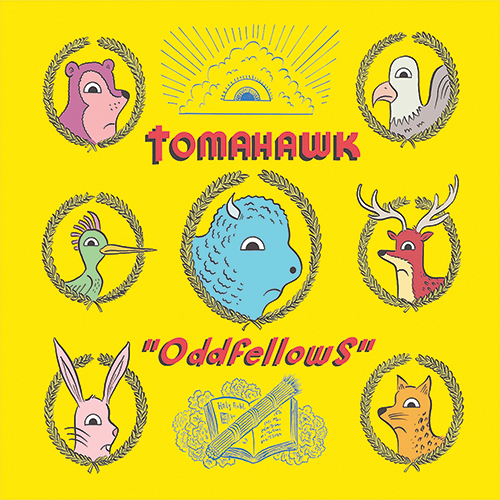If you’re not familiar with the work of Mike Patton, I would normally say something to the effect of, “stop what you’re doing and look him up.” In this case, however, Patton has touched so many different musical acts over the years that I’d feel comfortable rolling the dice on the premise that you’re already familiar with the man’s work.
Tomahawk is sharper than ever

If you’re not familiar with the work of Mike Patton, I would normally say something to the effect of, “stop what you’re doing and look him up.” In this case, however, Patton has touched so many different musical acts over the years that I’d feel comfortable rolling the dice on the premise that you’re already familiar with the man’s work.
Patton has been involved with several bands over the years, with Faith No More being his primary fame generator. But the list also includes Fantomas, Mr. Bungle, Peeping Tom, Lovage, The Dillinger Escape Plan and collaborations with Bjork, Rahzel, Melvins, Merzbow and more. The one conspicuously left off the list: Tomahawk.
Though Patton has gone through stages of love and hate with all of his projects, Tomahawk has been one of the more consistent entries on his resume. Even recently, with Faith No More’s reunion, Patton has found time to front yet another Tomahawk record, Oddfellows.
Patton only squeezes out a new Tomahawk record every four years and, normally, each one gets more and more experimental. With a name like Oddfellows and the album’s accompanying artwork, one might expect that it would be Patton’s weirdest musical foray since Mr. Bungle’s Disco Volante.
Guess what? It’s not.
In fact, most parts of Oddfellows feature Patton and company as the most mature, “normal” selves they’ve ever bled onto wax. Depending on how much stock you put into Patton’s legend, this could be a good or bad thing.
From an unbiased perspective, however, it’s unequivocally the tightest, most concise version of himself he’s ever been.
Oddfellows opens pretty straightforwardly as far as Tomahawk is concerned: A disjointed rhythm drags its broken legs across a musical scale as a sludgy riff fills each hole in the rhythmic composition. As expected, Patton has his share of dark, carny-emcee vocals peppered throughout, a technique gleaned from Mr. Bungle’s self-titled record.
Say what you will about Patton and his work in Faith No More, but the man is an unsung genius of rock music—and this is coming from a critic who doesn’t even enjoy a lot of his catalog.
It is here, however, among Tomahawk’s broken rhythm lines, that this type of half-growled vocal finds itself at home. This blackened delivery would be persona non grata in any band not containing Mike Patton. Those are the rules—I don’t make them, I just enforce them.
There isn’t a vocalist in music today who has the range Patton does—he’s a singer, a beat boxer, a human sound effects machine. That range is on full display throughout Oddfellows: The record retains that unquestionable variety while sounding more mature than any other Patton record. It’s no easy task, but somehow Patton shoehorns it all in without ever seeming overbearing or corny.
On Oddfellows, the band finds itself running the gamut of everything that rock music is, and nothing that it isn’t. Songs like the opening title track are slushy, penetrative cuts of rock action, whereas track two, “Stone Letter,” is almost like a top-down, wind-in-my-hair teen summer movie soundtrack, complete with driving beat and appropriately era-specific alt-rock guitar work behind it.
In fact, it’s as “pop” as Tomahawk gets on the whole record, and before you know it, Patton and ensemble have anchored a grappling hook from one side of rock music to the other and are tightroping the line across the gap over the course of just two tracks. It’s impressive, but is it enjoyable?
Well, mostly. And, rabid fanboy-ism aside, “mostly enjoyable” is about as good as a Mike Patton project is going to turn out, because there usually isn’t enough glue to hold the thing together.
Thankfully, much of the record is Patton using his powers for the greater good. The aforementioned “Stone Letter,” along with “South Paw” and “Waratorium,” are the most concise uses of Patton’s skills to date and are great, next-level-sounding rock music.
Unfortunately, as is normally the case with the Patton canon, there are a couple tracks that are simply throwaways. Tracks like “A Thousand Eyes” sound like tense scenes from retro horror movies, where the killer lurks just around the corner in the shadows. As the track rolls on, it never really picks up steam—but it certainly touches on almost every boring part of cheesy ’80s horror scores.
Another offending track is “I Can Almost See Them,” a typical Patton throwback in which the ingredients are: a bass line, one of those bright orange Halloween sound effects cassettes and some vintage Patton everything-but-the-kitchen-sink vocal musings scattered throughout.
While tracks like this add to most Patton releases, they’re a distraction here. Patton is trying to lay himself bare in this album and deliver honest rock music, but “I Can Almost See Them” sounds like a bit of cowardice at best and an offering of fanboy appeasement at worst.
Oddfellows
Ipecac recordings
Out January 29
4 stars
Though Patton and his merry men can do little harm in their experiments, some parts of Oddfellows lose traction because of outside influences, namely the production. One would think that his superb control over his voice—coupled with decades spent recording music—would grant Patton or his band of ragamuffins executive order of track mastering, but this is obviously not the case.
“White Hats/Black Hats” and “Rise Up Dirty Waters” see Patton’s vocal magic bag at its most exposed, and no amount of sorcery (outside of a recording engineer’s mixing console) can take the edge off those caterwauls.
Some tracks, though, like “South Paw,” feature phenomenal mixing, where Patton’s “regular” voice hovers in the middle, upwardly breaking free when it needs to.
After having recorded dozens of off-the-wall projects, it’s good to see Patton finally put out a straightforward rock record using his seasonings as just that, seasonings, instead of some of the other records where Patton really goes overboard.
The man is as unique a recording artist as we’ll likely witness in our lifetimes, and hearing his take on musical standards is refreshing and inspiring.
There are a couple flaws in Tomahawk’s blade, but it’s nothing that four more years in the Patton forge and a fresh perspective can’t fix.





